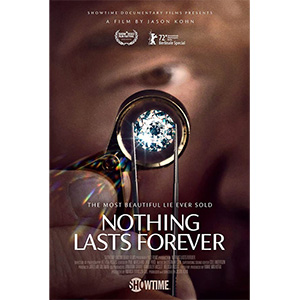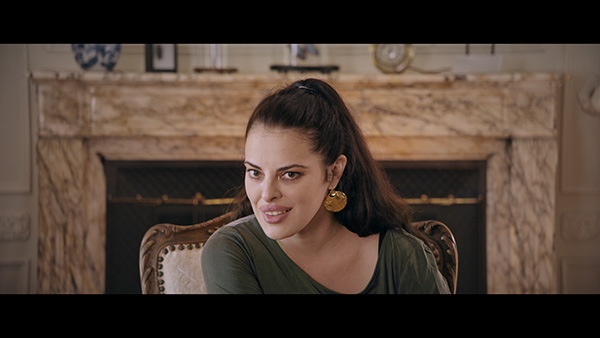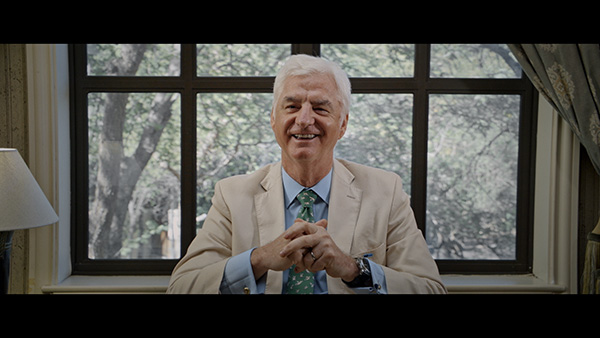
It’s impossible for me to objectively review Nothing Lasts Forever, the flashy new diamond documentary that will air this fall on Showtime. It’s full of people I know, conferences I’ve been to, and subjects I’ve spent decades writing about. There’s even a brief shot of me at one event, looking bored.
That said, here are my impressions, following a screening at BAM Rose Cinemas in New York City on June 26.
The film, directed by Jason Kohn (Manda Bala), is devoted to the lab-grown versus natural diamond debate, but it ultimately does both sides no favors. It’s clearly more hostile to natural diamonds, but it belittles lab-growns, too, dubbing them a “lie about a lie,” and “synthetics” so often that marketers might have to drag out that term again, as much as they hate it.
The film was exquisitely shot and edited and generally entertaining, though, at a few moments, it felt slow. Its least interesting stretches involved long takes of mundane visuals, like a box being opened, or a machine coming to life. Those played okay on the big screen, but might not hold viewers’ attention on a computer screen or a phone. (Aside from periodic screenings, like the one I attended in Brooklyn, the film is unavailable for viewing or streaming prior to its Showtime debut.)
One of the film’s stars, gemologist Dusan Simic, tells JCK that Kohn—who he counts as a friend (and vice versa)—did a “great” job with the film, noting that it got huge applause at the Berlin International Film Festival. But he admitted the film features some “brutal simplification.”
“When [on-screen commentators] talk about ‘truth’ and ‘lies,’ it is not a serious thing to discuss. It’s okay for entertainment. But to talk about seriously? Come on.”
On a recent webinar, Simic said the film was an improvement on Showtime’s trailer, which he called “garbage,” adding that even Kohn was “disappointed” with it.
Having seen both, I am not seeing much difference. If I had to sum up the film’s message, it would be “the diamond industry was created by marketing and will soon be destroyed.” All of which is in Showtime’s trailer.
The film’s other star is Aja Raden, the author, jewelry designer, and founder of Opinion Engineering, whose zippy one-liners made her an audience (and director) favorite. If Nothing Lasts Forever sometimes feels like a big Twitter fight, Raden has the best dunks.
“I liked that the movie didn’t make anyone look good,” Raden tells me. “A lot of documentaries fall into the trap of being commercials for an idea. [This] included different perspectives.”

My biggest beef with the film is that, despite giving a quick history of De Beers—including decades-old clips from its single-channel days—it misleads viewers into thinking De Beers’ monopoly is still intact. (At BAM, one post-film questioner asked Kohn about “the cartel.”)
When those long-ago clips were shot, De Beers’ market share was 80-90 percent. Today, it’s less than 25 percent. That’s a huge shift, which began 22 years ago. The diamond monopoly is over. That’s good. That matters.
The vintage footage noted that De Beers executives could not come to the United States because of the company’s antitrust issues. The film doesn’t supply more info on that topic, so the average viewer might think that’s still true. Yet, De Beers execs have regularly come to America for at least the last decade. The filmmakers probably saw them at the JCK shows they attended.
Nothing Lasts Forever never mentions either of those facts. By contrast, if you took a drink every time someone said “mixing,” you’d black out halfway through.
Of course, in this environment, pointing out that Alrosa is the world’s leading diamond producer isn’t exactly a win. But at least it’s true. To give viewers the impression that the diamond industry is still cartel-controlled, or that De Beers executives still can’t come to the United States, is, in the film’s parlance, a “lie about a lie.”
Kohn was unavailable for a full interview, but he did email a response on this issue, arguing that the end of the De Beers cartel “wasn’t relevant” to his story:
“Since this is a film that very much deals with the power of story-telling, it was important to show how De Beers was so successful in creating the ‘diamond dream.’ That information came out in one of our interviews and was visually depicted through vintage archival footage; it was a past-tense history of the company, essential to understanding how De Beers became the dominant voice in diamond marketing.
“One of the great challenges of telling any story is discovering what information is essential. How De Beers created their narrative and how that narrative has been maintained are obviously important to our story. Personally, I didn’t see how information about the events that changed De Beers’ percentage of market share was essential to understanding their actions regarding lab-grown diamonds.”
To be clear, I’m not suggesting the film should detail “events that changed De Beers’ market share”—which is a huge topic. I simply believe it should have communicated its market share has changed.
If a filmmaker is telling a true story about a subject, and they mention certain facts, they have an obligation to inform viewers that those facts have long changed, even if that hurts or complicates their story. And if they are not painting a true picture of the topic, then what are they doing?
At BAM, Kohn called his film “a character-based essay film with a plot.” He said it took 12 years to make and was particularly hard to “cast.”
“There are plenty of [industry] people who could talk about these subjects, but [when casting a documentary], you’re actually looking for characters. You’re not looking for people.…
“I think everybody [in the film] has plenty of opportunity to say their piece. Even if it’s an opinion that you don’t 100 percent agree with, if you don’t give it its space, and if you don’t understand everyone’s intention, to me, it feels dishonest.”
That’s a great guiding principle. I am not sure he followed it.
Kohn does let his “characters” talk at length, but he also puts his directorial thumb on the scale.
Take the film’s portrayal of Rapaport Group chairman Martin Rapaport and now-retired De Beers director Stephen Lussier, both of whom I know as human beings, rather than characters.
Kohn said that he wanted to detail the different subjects’ “origin stories.” But while the film mentions Lussier’s marriage to a member of the Oppenheimer family—twice—it never brings up that Rapaport is the son of two Holocaust survivors.
On occasion, both men’s words are undercut with immediate rebuttals as well as loaded music and visual choices, which, according to Screen Daily, “seem to offer coded authorial comments.”
Rapaport’s well-worn patter on synthetics does him few favors, and his musings on gender roles and woman’s equality came across as tin-eared, drawing laughter from the knowing Brooklyn crowd.
At BAM, Kohn said that a viewer at the film’s premiere in Berlin decided Rapaport was “maybe a villain” and “venal,” yet still “liked” him. I’ve known Martin for three decades, and have had issues with him, but would never call him venal.
Whether or not you agree with everything Rapaport says about lab-grown diamonds (I don’t), he could have made quite a bit of money listing them on his platform. As the film shows, he decided not to, because he didn’t believe it was the right thing to do. That is the opposite of venal.
Rapaport so failed to connect with the screening’s viewers that when he relayed the story of a retailer who was caught selling clarity-enhanced diamonds without disclosure, lost his business, and then, in Rapaport’s words, “drank jewelry cleaner and killed himself,” members of the audience giggled. I assume they were laughing at Rapaport’s blunt description, not the actual incident, but having interviewed that late jeweler, I know his ugly death was no joke.
And while Rapaport comes across as a “defensive” spewer of the party line, those in the trade understand he’s anything but.
If the film had a different focus, Rapaport may have even been portrayed as its hero, given his uncompromising stance against blood diamonds, his commendable push for Fair Trade gemstones, as well as his repeated clashes with certain industry members over his price list, which in the 1980s earned him death threats. (Rapaport has yet to see the film.)
Lussier—who both Variety and IndieWire misidentified as De Beers’ CEO—is allowed a long monologue about the importance of diamonds to Botswana’s economy. But that’s set against what one review called “an ironic montage” featuring explosions and a dead elephant.
That “sarcastic metaphor” is particularly strange. The filmmakers do not seem to have investigated whether Lussier’s comments are true—which they are. But they couldn’t let Lussier’s comments stand. If destroying the diamond industry meant hurting a developing country, that makes the documentary a lot less fun. So they tossed in dead animals and left it at that.
Simic says the dying-elephant shot was one thing he and Kohn fought about. “I told him this was completely unnecessary,” he says.

Simic plays the role of the film’s tragic hero, reduced to driving an Uber when his plan to insert a detectable chemical into every lab-grown diamond is quickly shot down. His idea, while well-intentioned—and not well-explained in the film—has an obvious flaw: growers would have to agree to it.
Even so, he hopes that the film will boost industry efforts on lab-grown diamond detection. He adds that, when the film was screened in Israel, dealers agreed with his concerns about possibly undisclosed synthetics. He believes either the Federal Trade Commission or the industry should set standards for diamond labs.
“Who can be a lab? What equipment do they need? To be a real lab, you need a half-million dollars of equipment.”
All worth discussing. While the conventional industry wisdom is that there’s not many undisclosed synthetics out there, it never hurts to be vigilant. COVID-19 has taught us that science can’t always keep up with an ever-changing threat.
At the film’s end, Simic is seen huddling with Chinese growers to devise a synthetic that will fool the testers.
What was the result of his test? “We don’t want to share that,” Simic says. “Jason and I agreed the audience will decide: Did I succeed or not?“
Finally, many JCK readers are undoubtedly curious: Will Nothing Lasts Forever hurt the trade?
Most of the pro reviewers thought so, as well as the non-pros.
While this was a distinct minority view among the trade people that attended the screening—just about all of whom were appalled—I think it probably won’t. First, the film doesn’t mention blood diamonds. When asked why, Kohn said at BAM: “Those kind of more political issues, they didn’t feel like they fit, emotionally, into a movie like this.”
The film is also airing on Showtime, not a big streaming service like Netflix or Hulu.
Even if the film is widely seen, one can never be sure of people’s reactions. Coproducer Amanda Branson Gill told me that she still likes diamonds. Raden believes business will continue as usual.
The film also features a lot of exquisite diamond photography—which calls to mind this anecdote from the Reagan era:
When the CBS Evening News ran a critical story in October 1984 about Reagan’s use of soothing images to obscure unpopular policies, reporter Lesley Stahl was astounded when White House aide Richard Darman telephoned to congratulate her. “You guys in Televisionland haven’t figured it out, have you?” Darman said. “When the pictures are powerful and emotional, they override if not completely drown out the sound.”
In the attention economy, having people watch a series of beautiful diamond shots could even boost sales.
“It’s good to be part of the conversation,” David Kellie, CEO of the Natural Diamond Council, said in January. “I would much rather be talked about than not.”
However one feels about the film, Simic believes it’s not worth getting upset about.
“It’s just a movie,” he says. “Most consumers, they’ll be interested, maybe for an hour. Then they’ll forget it in three days.”
Images courtesy of Showtime
- Subscribe to the JCK News Daily
- Subscribe to the JCK Special Report
- Follow JCK on Instagram: @jckmagazine
- Follow JCK on X: @jckmagazine
- Follow JCK on Facebook: @jckmagazine






